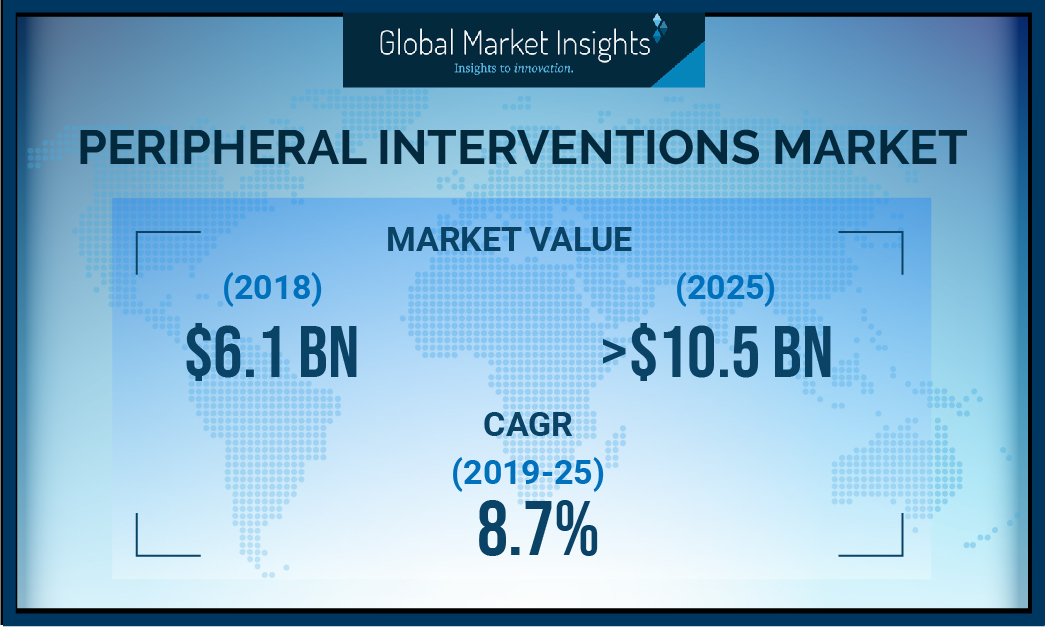Peripheral Interventions Market will achieve 8.7% CAGR up to 2025

The worldwide Peripheral Interventions Market is projected to cross USD 10.5 billion by 2025. High incidence of cardiovascular disorders will significantly impact the peripheral disease treatment market in the near future. Rising prevalence of coronary heart disease, cerebrovascular disease and peripheral artery disease (PAD) will lead to greater peripheral vascular device adoption. Risk factors such as smoking, unhealthy lifestyle, atherosclerosis, and hypertension will further contribute peripheral intervention market growth. Additionally, due to comorbidities of peripheral artery disease and complexities, balloon angioplasty and stenting devices will foresee substantial demand in the upcoming years.
Rapidly advancing technologies in vascular intervention systems will yield competitive market growth opportunities. Leading market players offering advanced minimally invasive devices such as drug-eluting stents, drug-coated balloons, catheters, guidewires, etc. coupled with superior benefits have substantially increased the procedural success rate. For instance, Xience Sierra introduced by Abbott is the newest stent technology, offering various benefits such as flexibility, long length, small diameter and greater compatibility. Thus, rising demand for minimally invasive processes, advancements, and growing expenditure on R&D, will lead to notable development in peripheral vascular devices in the foreseeable future.
Guide wires product segment is expected to show significant growth owing to growing incidence of target diseases such as ischemic heart disease, nephrolithiasis and brain aneurysm. Also, increase in application of guidewires in neurovascular and peripheral interventions is also among key factors assisting the segment expansion. In addition, technology breakthroughs in accessibility, affordability, enhanced flexibility coupled with minimal deformity and exemplary tip shape retention are key factors that will drive the segmental size in the forthcoming years.
Atherosclerosis application segment is forecast to expand at significant pace over the analysis period. Atherosclerosis is directly associated with consumption of high fat dietary habit and smoking. Thus, growing epidemiology of hypertension and atherosclerosis coupled with rising risk factors leading to rapid disease development will impact the application of peripheral vascular devices for atherosclerosis. Furthermore, rising approval and increase in the R&D for treatment of atherosclerosis are some of the major factors contributing to the segment growth over the forecast period.
To access a sample copy of the "Peripheral Interventions Market" report in detail along with the table of contents @ https://www.gminsights.com/request-sample/detail/2915
The peripheral interventions market in hospitals accounted for highest revenue share in 2018. Increasing patient pool suffering from cardiovascular diseases, thereby increasing hospitalizations, will positively impact the segment size. Availability of technologically advanced devices coupled with favorable reimbursement policies in hospitals will further boost business growth during the analysis period. Furthermore, advanced healthcare infrastructure, assisting set-up of catheter laboratory will boost hospitals segment expansion in the upcoming years.
The Canada peripheral interventions market will witness substantial growth in foreseeable future. Growing geriatric population, adoption of peripheral intervention device coupled with advanced medical treatment pattern will act as positively influencing factor for the market growth. Furthermore, presence of large patient pool, undiagnosed with PAD, and presence of improving peripheral intervention infrastructure will offer robust expansion opportunities in the country.










